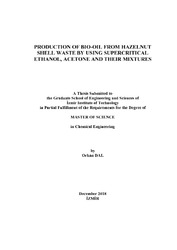Please use this identifier to cite or link to this item:
https://hdl.handle.net/11147/7201| Title: | Production of Bio-Oil From Haelnut Shell Waste by Using Supercritical Ethanol, Acetone and Their Mixtur | Other Titles: | Fındık kabuğu atıklarından kritiküstü etanol, aseton ve bu çözgenlerin karışımları kullanılarak biyo-yağ eldesi | Authors: | Dal, Orkan | Advisors: | Yüksel Özşen, Aslı | Keywords: | Supercritical fluids Biomass |
Publisher: | Izmir Institute of Technology | Source: | Dal, O. (2018). Ptoduction of bio-oil from haelnut shell waste by using supercritical ethanol, acetone and their mixtur. Unpublished master's thesis, Izmir Institute of Technology, Izmir, Turkey. | Abstract: | The goal of this study was to investigate effect of reaction temperature, reaction time and solvent ratio (ethanol/acetone v/v%) on bio-oil yield, solid conversion and product distribution. Direct thermochemical biomass degradation to obtain bio-oil by using organic solvents is not a new process type, and it has some advantages over hydrothermal liquefaction technique. However, in literature, to our best knowledge, there is no study about hazelnut shell decomposition by using ethanol, acetone and their mixtures at sub/supercritical conditions. In this study, experiments were carried out between 220-300 °C, at three different temperatures (30, 60 & 90 min) for five different solvent ratios. Highest solid conversion achieved at 300 °C by using pure ethanol was 64.2%, whereas highest bio-oil yield was found as 44.2% at 300 °C with 50/50 (EtOH/Ac: v/v). Ethanol and acetone showed different characteristics during the experiments and their effect on the conversion and bio-oil yield were discussed. Statistical analysis showed that time, temperature, ratio and temperature-time are affecting parameters for the conversion and bio oil yield while time-ratio and temperature-ratio are not. According to GC-MS results, product distribution changed with respect to solvent type and ratio. Bu çalışmanın amacı, fındık kabuğu atıklarından kritiküstü etanol, aseton ve bu çözgenlerin karışımları kullanılarak üretilecek biyo-yağın veriminin, fındık kabuğu dönüşüm oranının ve ürün dağılımının, reaksiyon sıcaklığı, reaksiyon süresi ve çözgen oranlarından nasıl etkileneceğini araştırmaktır. Daha önce, fındık kabuğu atıkları kullanılarak kritiküstü etanol, aseton ve bu çözgenlerin karışımları kullanılarak biyo-yağ eldesi literatürde araştırılmamıştır. Deneyler, sıcaklık olarak 220, 260 ve 300 oC, reaksiyon süresi olarak 30, 60, 90 dakika, 5 farklı etanol/aseton oranında yapılmıştır. En yüksek katı dönüşümü, saf etanol kullanılarak 300 oC’de 64.2% olarak elde edilirken; en yüksek biyo-yağ verimi, etanol/aseton hacimsel oranının 50/50% ve reaksiyon sıcaklığının 300 oC olduğu koşullarda 44.2% olarak bulunmuştur. Etanol ve aseton biyoyağ veriminde ve katı dönüşümünde farklı etkilere sahiptir. İstatistiksel analiz sonucunda; reaksiyon sıcaklığı, reaksiyon süresi, çözgen oranları katı dönüşümü ve biyo-yağ verimi üzerinde etkiye sahipken, reaksiyon süresi*çözgen oranı ve reaksiyon sıcaklığı*çözgen oranı gibi iki yönlü değişkenler etkiye sahip değildir. GC-MS sonuçlarına göre ürün dağılımı çözgen tipi ve çözgen oranına göre değişiklik göstermiştir. |
Description: | Thesis (Master)--Izmir Institute of Technology, Chemical Engineering, Izmir, 2018 Includes bibliographical references (leaves: 50-54) Text in English; Abstract: Turkish and English |
URI: | https://hdl.handle.net/11147/7201 |
| Appears in Collections: | Master Degree / Yüksek Lisans Tezleri |
Files in This Item:
| File | Description | Size | Format | |
|---|---|---|---|---|
| T001882.pdf | MasterThesis | 4.87 MB | Adobe PDF |  View/Open |
CORE Recommender
Items in GCRIS Repository are protected by copyright, with all rights reserved, unless otherwise indicated.